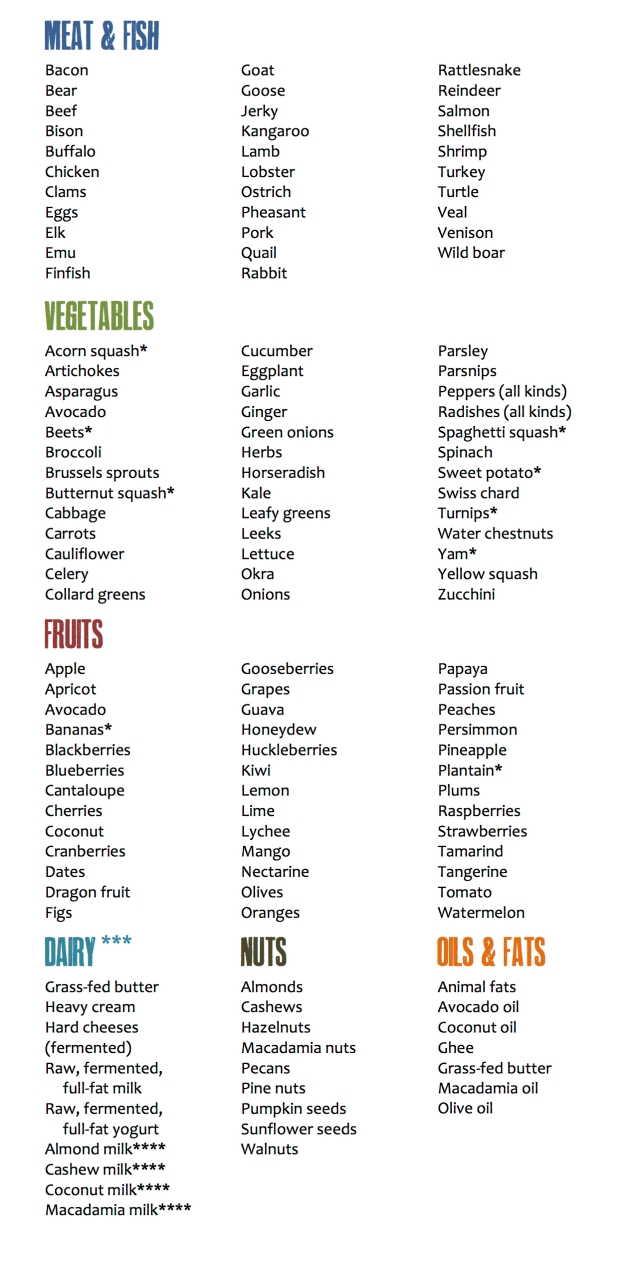There is one question I am asked more often than any other: What can I eat? Living a Paleo lifestyle definitely gets easier as time moves on, but it can be incredibly difficult to get started. An internet search of “Paleo Foods” yields millions of results, creating a difficult-to-navigate journey into a dark hole.
I am by no means an expert. I don’t have a nutritional degree, I’m not a doctor, but I live the Paleo lifestyle every day (well, most days, sometimes you just need a piece of cake!). In this post, you’ll find the basic tenets of the Paleo lifestyle. There are a few main principles that will guide your food choices and make it easier to make decisions about what you should be ingesting. I’ve also included an “Eat This, Not That!” list that should help give you some substitutes for your favorite non-Paleo friendly foods. Keep in mind that this isn’t written in stone, it’s a guideline for helping you live a healthier life. You’ll find what works for you as you try new things. Keep in mind, we live what some would consider a “Primal” lifestyle – we eat hard cheeses, high-fat dairy products, butter, and Greek yogurt. You can adjust your diet based on your unique needs or sensitivities.
If after reading the post, you still have questions, feel free to leave a comment and I’d be happy to do my best to help. Don’t be discouraged if you fall off the wagon – get back on! One slice of cheesecake shouldn’t derail your progress. Mark Sisson, of Mark’s Daily Apple, and author of The Primal Blueprint, really hit home with me when he said that the idea is to reach for 100% compliance, knowing that you’ll probably be closer to 80%. If you go into this change with the understanding that you can never be perfect, those little missteps become a lot less devastating and more manageable. Living this lifestyle isn’t easy, but it’s incredibly rewarding.

Fat Isn’t Your Enemy | The Paleo lifestyle relies on in consumption of good fats for a balanced diet. People think you are crazy when you tell them you are on a high-fat diet (that’s what the Paleo lifestyle is!). My favorite Paleo blogger and writer, Mark Sisson, does a fantastic job of summarizing the explanation for a high-fat diet in his post on a healthy high-fat diet. A recent Time Magazine article was received with critical acclaim when it plowed through the “research” we’ve been fed since the 1980’s, claiming that we needed to be on a low-fat, whole-grain diet to be healthy. The article, Ending the War on Fat, asserts that we are more unhealthy than ever before, as we replaced fat in our diets with carbs and sugar, the incidence of obesity and Type II Diabetes skyrocketed. What are “good fats”? Those that are not oils derived from grains – stay away from canola, corn, and soy oil. Avocado oil is fantastic for high heat cooking, while olive and coconut do a great job for raw preparations or in baking. Don’t forget our delicious friend, butter.
Carbs = Sugar (Sugar Is Your Enemy) | This is the one that gets most people. It’s so incredibly difficult to give up sweets, but once you do it, I promise you that you’ll wonder how you ever ate a Krispy Kreme doughnut (or two). Things start to taste overwhelmingly sweet, nearly inedible. The first time I experienced this was while eating an apple sample given to me in a Whole Foods. The honeycrisp wedge tasted like someone had dipped it in corn syrup and then wrapped it in cotton candy. It was alarming. Imagine now, trying to eat a chocolate chip cookie, with nearly twice the amount of sugar in it than the apple? It’s sickening.
The takeaway from the carb story is to eliminate them right from the very beginning. Now keep in mind, some carbs are okay for you (sweet potatoes, cauliflower, squash, fresh fruit, etc.). Think of them as “safe starches”. They have a low-glycemic index and have a smaller impact on insulin production in your body. The jist of it: no refined sugars, no artificial sweeteners, no grains (including rice, quinoa, corn (it’s actually a grass) and everything else previously thought to be delicious), no beans/legumes (this includes peanuts!), and no white potatoes (a baked potato has a GI of 85 – glucose is 100!). Check out The University of Sydney’s website for more information on glycemic index, why it is important, and the rating of thousands of common foods. Of course, Mark Sisson has lots of great articles on why we shouldn’t eat grains, so be sure to check out Mark’s Daily Apple for a ton of relevant information.
If You Can’t Pronounce It, Don’t Eat It | Basically, if it is pre-packaged, contains preservatives, or Lucy the cave-lady wouldn’t have been able to eat it, then you shouldn’t eat it either. Keep your body free from chemicals, additives, and overall harmful substances. Stick to fresh, grass-fed meat (you are what you eat, so if your cow at corn, you may as well have), low-carb fruits and vegetables, nuts, and good fats.
Protein Is Your Friend | Along with a high amount of fat, your Paleo diet will also consist of a lot of protein. When you choose high-quality, lean proteins, you will stay fuller, longer. This doesn’t mean eat three pounds of 80/20 ground beef every day. Variety is the spice of life, and it keeps you healthy. Change things up often, eat beef, pork, chicken (and eggs), turkey, and a variety of fresh fish. A four ounce portion of most meat yields about 20 grams of protein – which is a fantastic way to fill you up without overloading your system. We like to shoot for at least 60 grams of protein every day, but again, that will vary depending on your specific caloric and dietary needs.
Bacon is often a topic of discussion among Paleo-enthusiasts. We love bacon – it’s delicious, it goes with everything, and it’s delicious (yes, I said it twice because it’s doubly-true). What is important to keep in mind when buying bacon? Two simple things: no sugar, no nitrates. We already know sugar is bad for us, so don’t go buying the brown sugar cured variety. Nitrates are also no good, so keep away from any brands that have it added. Hempler’s makes a great applewood smoked version that I love – check out their website to see if you can find it in your area. There are bound to be local producers of Paleo bacon in your area, just check the labels.
And the biggest one of all…
Eat Real Food. | This is the crux of the entire Paleo plan. If it can sit on a shelf for 3 years, don’t eat it. If it has an ingredient list a mile long with a bunch of preservatives, skip it. Stick to brightly colored fruits and veggies (the color means they have a lot of nutrients and a large variety of colors equals a large variety of nutrients), fresh proteins, and hearty nuts, seeds and fats. If you aren’t sure if you should eat it, Google it and see what everyone else has to say. After you follow the Paleo lifestyle for a couple of months it will become second-nature. You’ll know what is good for you, what you can have as a “treat”, and what you should stay away from completely.
As you navigate through this complex world we live in, living every day with a million things to do and not enough time to do them, you’ll have cravings. They will get less intense, but they will still be there. You’ve been eating a specific way your entire life, that isn’t just going to change overnight. Fight the urge and you’ll feel better for doing so. To help keep you on track, here’s a quick list of all the things you should be eating, instead of those evil, non-Paleo foods that we all dream about at night (or run to at 2 PM when the sugar demons hit).

Share this:
-
Click to share on Facebook (Opens in new window)
-
Click to share on Pinterest (Opens in new window)
-
Click to share on Google+ (Opens in new window)
-
Click to share on Pocket (Opens in new window)
-
Click to share on Reddit (Opens in new window)
-
More
-
Like this:
Like Loading...






 *Starchy fruits/vegetables are higher in calories and carbohydrates, so eat them in moderation. **Fruits are high in fructose, a type of sugar. While this is okay on the Paleo plan, they should be consumed in moderation to ensure proper insulin production.
*Starchy fruits/vegetables are higher in calories and carbohydrates, so eat them in moderation. **Fruits are high in fructose, a type of sugar. While this is okay on the Paleo plan, they should be consumed in moderation to ensure proper insulin production.

